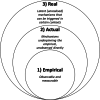Making implementation science more real
- PMID: 35752754
- PMCID: PMC9233332
- DOI: 10.1186/s12874-022-01661-2
Making implementation science more real
Abstract
Implementation science in healthcare aims to understand how to get evidence into practice. Once this is achieved in one setting, it becomes increasingly difficult to replicate elsewhere. The problem is often attributed to differences in context that influence how and whether implementation strategies work. We argue that realist research paradigms provide a useful framework to express the effect of contextual factors within implementation strategy causal processes. Realist studies are theory-driven evaluations that focus on understanding how and why interventions work under different circumstances. They consider the interaction between contextual circumstances, theoretical mechanisms of change and the outcomes they produce, to arrive at explanations of conditional causality (i.e., what tends to work, for whom, under what circumstances). This Commentary provides example applications using preliminary findings from a large realist implementation study of system-wide value-based healthcare initiatives in New South Wales, Australia. If applied judiciously, realist implementation studies may represent a sound approach to help optimise delivery of the right care in the right setting and at the right time.
Keywords: Context; Implementation science; Mechanism; Outcome; Realist evaluation; Realist review; Realist synthesis; Theory.
© 2022. The Author(s).
Conflict of interest statement
None declared.
Figures




References
Publication types
MeSH terms
LinkOut - more resources
Full Text Sources
Medical

